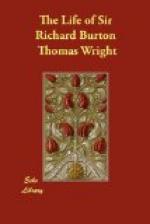At Oxford, Burton met Professor Sayce, and did more literary work “under great difficulties” at the Bodleian, though he escaped all the evil effects; but against its wretched accommodation for students and its antediluvian methods he never ceased to inveigh. Early in August he was at Ramsgate and had the amusement of mixing with a Bank Holiday crowd. But he was amazingly restless, and wanted to be continually in motion. No place pleased him more than a day or two.
155. The Gypsy, August 1888.
Among the deal tables in Burton’s rooms at Trieste was one devoted to a work on the Gypsies, a race concerning whom, as we have seen, he had long been curious. He had first proposed to himself to write on the subject when he was in Sind, where he had made investigations concerning the affinity between the Jats and the Gypsies; and now with abundance of leisure he set about the work in earnest. But it was never finished, and the fragment which was published in 1898[FN#557] contains, Mr. Watts-Dunton[FN#558] assures me, many errors. Burton’s idea was to describe the Gypsy in all lands. Perhaps he is happiest in his account of the Spanish Gypsy woman. “Their women,” he says, “sell poultry and old rags. ... and find in interpreting dreams, in philter selling, and in fortune-telling the most lucrative industries. They sing, and play various instruments, accompanying the music with the most voluptuous and licentious dances and attitudes; but woe to the man who would obtain from these Bayaderes any boon beyond their provocative exhibition. From the Indus to Gibraltar, the contrast of obscenity in language and in songs with corporal chastity has ever been a distinctive characteristic. ... Gypsy marriages, like those of the high caste Hindus, entail ruinous expense; the revelry lasts three days, the ‘Gentile’ is freely invited, and the profusion of meats and drinks often makes the bridgegroom a debtor for life. The Spanish Gypsies are remarkable for beauty in early youth; for magnificent eyes and hair, regular features, light and well-knit figures. Their locks, like the Hindus, are lamp black, and without a sign of wave:[FN#559] and they preserve the characteristic eye. I have often remarked its fixity and brilliance, which flashes like phosphoric light, the gleam which in some eyes denotes madness. I have also noticed the ‘far-off look’ which seems to gaze at something beyond you and the alternation from the fixed stare to a glazing or filming of the pupil."[FN#560]
This peculiarity of the gypsy’s eyes, Burton had himself, for which reason alone, some writers, as we have already observed, have claimed him for the tribe. But he shared other peculiarities with them. For example, there was his extraordinary restlessness— a restlessness which prevented him from every settling long in any one place. Then, like the gypsies, he had an intense horror of a corpse—even of pictures of corpses. Though brave to temerity he avoided churchyards,




